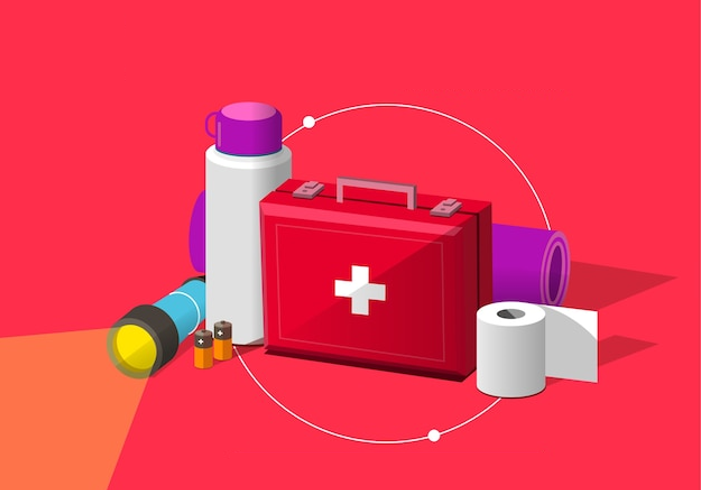
July 19, 2024
Keep This Emergency Kit at Home for the Rainy Season
Living in our beautiful country, we know all too well the importance of being prepared for typhoon season. Imagine the rain pounding against your windows, the wind howling outside, and all of a sudden the electricity goes out. What do you do? This scenario shows the importance of having an emergency kit ready to go. Whether you're starting from scratch or looking to upgrade your existing kit, this guide will walk you through everything you need to ensure safety and comfort for you and your loved ones during a typhoon or other natural disasters.
Why You Need an Emergency Kit
An emergency kit is your lifesaver when the unexpected happens. It's more than just a supply kit; it makes sure you have everything you need to stay safe, nourished, and informed until things get back to normal. Plus, having one gives you peace of mind, knowing that you're ready for whatever Mother Nature throws your way.
Building Your Emergency Kit: Essentials to Include
Water: Your Top Priority
Water is non-negotiable. Each person should have at least 7.5 liters per day for drinking, cooking, and hygiene. Typhoons can disrupt water supplies by damaging pipes, so it's crucial to have enough stored for several days. Consider investing in sturdy water containers that are easy to transport and store safely.
Non-Perishable Food: Nutrition in Any Situation
When the power is out and cooking isn't an option, non-perishable food becomes your best friend. Stock up on canned goods, cereals, energy bars, and dried fruits. Opt for items that are easy to open and require minimal preparation. Don't forget to include a manual can opener in your kit—a small tool that can make a big difference.
First Aid Kit: Be Prepared for the Unexpected
Accidents happen, especially during emergencies. A well-stocked first aid kit is essential. Include items like bandages, antiseptics, pain relievers, scissors, tweezers, and adhesive tape. Don't forget to include any medications specific to your family's needs. Store everything in a waterproof container or bag to keep supplies clean and dry.
Health and Sanitation: Stay Clean, Stay Healthy
Hygiene is critical during disasters to prevent illness. Pack personal hygiene items such as hand sanitizer, wet wipes, soap, toothbrushes, toothpaste, and hygiene products. Include any prescription medications your family members require, and don't forget insect repellent—a small but important item to ward off mosquitoes during stagnant water conditions.
Emergency Gear: Tools for Survival
Being prepared means having the right tools at your disposal. Include a battery-powered or hand-crank radio to stay informed about weather updates and emergency alerts. A flashlight with extra batteries, a whistle for signaling, and a multi-tool or Swiss army knife can also come in handy. Garbage bags serve multiple purposes—from keeping belongings dry to makeshift ponchos or ground cover.
Essential Documents and Cash: Protect Your Assets
Keep important documents like identification papers, insurance policies, birth certificates, and property deeds in a waterproof container or sealed plastic bag. Having these documents readily accessible can expedite recovery processes after a disaster. Include some cash in small denominations, as ATMs and card machines may not be operational during power outages.
Additional Considerations for Your Kit
Clothing and Bedding: Prepare for the Weather
Pack a change of clothes for each family member, including sturdy shoes and rain gear. Include blankets or sleeping bags to keep warm during cooler temperatures. Comfort and warmth can make a significant difference in maintaining morale and well-being during stressful situations.
Tools and Supplies: Be Resourceful
A basic toolkit containing wrenches, pliers, screwdrivers, and duct tape can help you address minor repairs or secure your home. Consider adding plastic sheeting, rope, and nails for makeshift repairs or creating temporary shelters. Being resourceful with the tools you have can make a big difference in your ability to cope and stay safe.
Communication Devices: Stay Connected
While cell phones are essential, they may not always be reliable during emergencies. Include a battery-powered or hand-crank radio to receive updates and emergency information. A whistle can also be invaluable for signaling for help if needed.
Entertainment and Comfort: Ease Stress
Disasters can be stressful for everyone, especially children. Pack books, games, or other activities to keep spirits up and minds occupied during downtime. These simple comforts can provide much-needed distraction and relief during challenging times.
The Role of Home Insurance: Safeguarding Your Future
While not a physical item in your emergency kit, home insurance is a critical supplement to your disaster preparedness plan. It provides financial protection against damage or loss to your property caused by floods, storms, or other natural disasters. Consider exploring options like Cocogen’s Home Excel Plus Insurance to ensure your home and belongings are adequately covered, giving you peace of mind knowing you're prepared for the worst.
Maintaining Your Emergency Kit: Tips for Success
Regularly Update and Rotate Supplies
Check your emergency kit every six months to ensure all supplies are up to date and in good condition. Replace expired food, medications, and batteries as needed. Keep track of expiration dates and rotate items to ensure freshness and functionality when you need them most.
Store Your Kit in a Convenient Location
Choose a designated spot that is easily accessible to all family members. Ideally, your emergency kit should be stored in a cool, dry place away from direct sunlight. Ensure everyone knows where it is and how to access it quickly in an emergency.
Involve Your Family in Preparedness
Prepare your family for emergencies by discussing your emergency plan and reviewing the contents of your kit regularly. Practice evacuation routes and emergency procedures so everyone feels confident and capable during a crisis. Encourage open communication and emphasize the importance of staying calm and focused.
Final Thoughts: Embracing Preparedness
Building a comprehensive emergency kit is not just about gathering supplies—it's about taking proactive steps to protect yourself and your loved ones. By investing time and effort into preparation now, you're ensuring that you'll be ready to face any challenge that comes your way. Typhoons are a reality of life in the Philippines, but with the right preparations, you can weather the storm with resilience and confidence.
Inquire now for more information on how to protect your home and family. Contact Cocogen through the contact form, email client_services@cocogen.com, or call the hotline at (02) 8830-6000. Our team is dedicated to helping you safeguard your home and ensure your family's safety in any situation.
Remember, preparation is key. Stay informed, stay prepared, and stay safe. Together, we can weather any storm that comes our way.
****
The views expressed are those of the author and do not necessarily reflect the views of Cocogen Insurance, Inc.
Other Blog Posts

Stay protected with earthquake preparedness tips for Filipino homes. Learn safety steps and how Home ...
Stay school-ready with these back-to-school computer tips. Keep your device secure, updated, and pro ...

Learn how to protect yourself from online scams, online fraud, and identity theft in 2025, plus how ...









